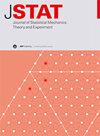Fluctuation-induced first order transition to collective motion
IF 2.2
3区 物理与天体物理
Q2 MECHANICS
Journal of Statistical Mechanics: Theory and Experiment
Pub Date : 2024-08-07
DOI:10.1088/1742-5468/ad6428
引用次数: 0
Abstract
The nature of the transition to collective motion in assemblies of aligning self-propelled particles remains a long-standing matter of debate. In this article, we focus on dry active matter and show that weak fluctuations suffice to generically turn second-order mean-field transitions into a ‘discontinuous’ coexistence scenario. Our theory shows how fluctuations induce a density-dependence of the polar-field mass, even when this effect is absent at mean-field level. In turn, this dependency on density triggers a feedback loop between ordering and advection that ultimately leads to an inhomogeneous transition to collective motion and the emergence of inhomogeneous travelling bands. Importantly, we show that such a fluctuation-induced first order transition is present in both metric models, in which particles align with neighbors within a finite distance, and in ‘topological’ ones, in which alignment is based on more complex constructions of neighbor sets. We compute analytically the noise-induced renormalization of the polar-field mass using stochastic calculus, which we further back up by a one-loop field-theoretical analysis. Finally, we confirm our analytical predictions by numerical simulations of fluctuating hydrodynamics as well as of topological particle models with either k-nearest neighbors or Voronoi alignment.波动诱发向集体运动的一阶过渡
在对齐自走粒子的集合体中,向集体运动过渡的性质仍是一个长期争论的问题。在这篇文章中,我们将重点放在干活性物质上,并证明微弱的波动足以将二阶平均场过渡转变为 "不连续 "共存情景。我们的理论展示了波动是如何诱发极场质量的密度依赖性的,即使这种效应在均场水平上并不存在。反过来,这种对密度的依赖会引发有序和平流之间的反馈回路,最终导致向集体运动的非均质过渡和非均质旅行带的出现。重要的是,我们证明了这种由波动引起的一阶转变既存在于粒子与相邻粒子在有限距离内对齐的度量模型中,也存在于 "拓扑 "模型中,其中对齐是基于更复杂的相邻集合构造。我们利用随机微积分对噪声引起的极场质量重正化进行了分析计算,并通过一回路场理论分析进一步予以支持。最后,我们通过对波动流体力学以及具有 k 近邻或 Voronoi 排列的拓扑粒子模型进行数值模拟,证实了我们的分析预测。
本文章由计算机程序翻译,如有差异,请以英文原文为准。
求助全文
约1分钟内获得全文
求助全文
来源期刊
CiteScore
4.50
自引率
12.50%
发文量
210
审稿时长
1.0 months
期刊介绍:
JSTAT is targeted to a broad community interested in different aspects of statistical physics, which are roughly defined by the fields represented in the conferences called ''Statistical Physics''. Submissions from experimentalists working on all the topics which have some ''connection to statistical physics are also strongly encouraged.
The journal covers different topics which correspond to the following keyword sections.
1. Quantum statistical physics, condensed matter, integrable systems
Scientific Directors: Eduardo Fradkin and Giuseppe Mussardo
2. Classical statistical mechanics, equilibrium and non-equilibrium
Scientific Directors: David Mukamel, Matteo Marsili and Giuseppe Mussardo
3. Disordered systems, classical and quantum
Scientific Directors: Eduardo Fradkin and Riccardo Zecchina
4. Interdisciplinary statistical mechanics
Scientific Directors: Matteo Marsili and Riccardo Zecchina
5. Biological modelling and information
Scientific Directors: Matteo Marsili, William Bialek and Riccardo Zecchina

 求助内容:
求助内容: 应助结果提醒方式:
应助结果提醒方式:


